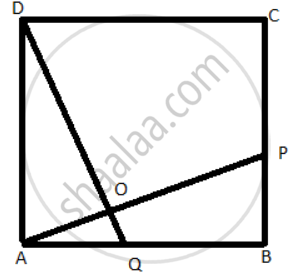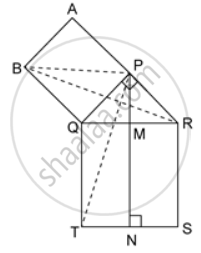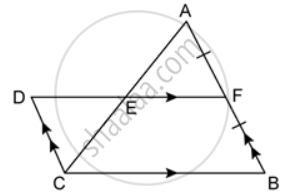Advertisements
Advertisements
प्रश्न
ABCD is a square. A is joined to a point P on BC and D is joined to a point Q on AB. If AP = DQ;
prove that AP and DQ are perpendicular to each other.
उत्तर

ABCD is a square and AP = PQ
Consider ΔDAQ and ΔABP,
∠DAQ = ∠ABP = 90°
DQ = AP
AD = AB
ΔDAQ ≅ ΔABP
⇒ ∠PAB = ∠QDA
Now,
∠PAB + ∠APB = 90°
also ∠QDA + ∠APB = 90° ...[∠PAB = ∠QDA]
Consider ΔAOQ by ASP
∠QDA + ∠APB + ∠AOD = 180°
⇒ 90° + ∠AOD = 180°
⇒ ∠AOD = 90°
Hence, AP and DQ are perpendicular.
APPEARS IN
संबंधित प्रश्न
All squares are rhombuses and also rectangles.
All squares are not parallelograms.
Explain how a square is a quadrilateral
Explain how a square is a rhombus.
Explain how a square is a rectangle
Prove that the bisectors of the interior angles of a rectangle form a square.
In square PQRS :
(i) if PQ = 3x – 7 and QR = x + 3 ; find PS
(ii) if PR = 5x and QS = 9x – 8. Find QS
Prove that the quadrilateral formed by joining the mid-points of a square is also a square.
In the given figure, ΔPQR is right-angled at P. PABQ and QRST are squares on the side PQ and hypotenuse QR. If PN ⊥ TS, show that:
(a) ΔQRB ≅ ΔPQT
(b) Area of square PABQ = area of rectangle QTNM.
In the given figure AF = BF and DCBF is a parallelogram. If the area of ΔABC is 30 square units, find the area of the parallelogram DCBF.
